Channel Crossing
New World Record!
6/11/06 travelling Dover (UK) - Calais (France), two 'Dutton' UK made amphibious cars piloted by Doug Hilton with first mate Adam solomon in one car and the other by Tim Dutton creator and manufacturer of the cars, crossed the English channel starting just after 10.00 and finally pulled out of the water well after darkness onto the beach at Calais after an eventful (and wet) 7 hours and 9 minutes fighting against waves, changing winds and being set miles to the west by the 7 metre plus tidal rips. Total distance covered 49 Km (30.4 miles). Average speed 6.7Km/hr (4.2 mph).
The Day
Doug Hilton, Instigated the crossing to protest against the unfair imposition of landfill tax on Buckland lake wildfowl reserve.
The amphibious car was decorated with goose stickers, the reserve name and we had ‘Percy’ the worlds only plastic goose trained to follow an amphibious car, flying from the mast.
When calling car maker Tim Dutton, to ask if there was anything needed before tackling such a crossing, we were told – “nothing, but I have to bring my car too”.
This actually worked quite well because as far as we were aware, the only previous attempt to cross with two cars, was in 1965 using two 'Amphicars' with one having to be towed to France.
A calm period in August looked good to us but last moment intermittent electrical problems (the blight of any modern engine) occurred and the weather simply fell apart leading to a hugely frustrating delay.
The English Channel with its difficult sea conditions, protector against countless invasion attempts of this small island, was now stopping us going the other way! Big seas caused by far away storms run into this tiny neck of sea. These come up from the West and down from the North sea to collide at Dover, producing highly confused waves with very short intervals between them (chop). Tide and wind also pile up and with wind against tide it becomes one of the most unpredictable sea areas in the world.
We sat glued to the daily forecasts, while the tail end of American hurricane systems and the onset of winter drove in one bad weather system after another. We were still waiting three months later when at last, a possible 24 hour weather eye appeared. We grabbed it, hoping for the best in what was now winter with very short daylight hours. Not at all what we had planned but the protest still needed doing.
An amusing French law forbids any non-standard vessel from landing in France or leaving and despite the fact that our cars would keep going even if the wind stopped (unlike a yacht), they were classed nevertheless as non-standard. The only way around this is to hire a French authorised channel pilot boat to accompany the crossing.
Standing in the early morning darkness, my hand ran along her frozen hull – would we do it? 70 miles later at Dover, still waiting for our channel pilot to arrive, two very good friends Rene and Katty from Belgium unexpectedly appear. These two between them have had more hair raising adventures (‘Amphibidiver’ at www.landairandsea.org ) than I have had hot dinners and yet they have travelled for over six hours and across three countries just to see us.
A late gathering, followed by a quick transfer of hoped to be unnecessary spare fuel plus one photographer (Ben Plewes ) and across to the slipway. Frustration mounts as we are refused permission to launch by Dover Port Authorities, claiming the channel pilot had not notified them of the crossing attempt. They finally agreed to permit the launch on receipt of a signed £5 million GBP indemnity (presumably in case we sunk a roll-on-roll-off car ferry).
Going through our pockets and chucking in the Euro coin we found in the car park, we reconed we could just about do it and so, signed it all away! They then told us we had to wait for a health and safety lecture on the basis that what we were intending to do was considered bloody dangerous!
I guess they get all sorts of people trying to cross the channel with absolutely no idea what they are about to take on, or of the danger they may create for others – so its OK you guys at Dover Port, we know you were only doing your duty and can look on it kindly (now)!
 Smiles eventually replaced officialdom after the pilot ran all the way from the inner harbour to speak with them but we were now seriously burning daylight and over one hour late. It was a relief when at last both cars slid gracefully into the water from the narrow slipway and the raucous clatter of the engine rose as rev’s built for full speed. Shadowing us was a huge Dover harbour patrol boat (much bigger than us anyway) monitoring our progress across the massive harbour towards the Western entry. The reason for their interest soon became obvious - they knew what we did not.
Smiles eventually replaced officialdom after the pilot ran all the way from the inner harbour to speak with them but we were now seriously burning daylight and over one hour late. It was a relief when at last both cars slid gracefully into the water from the narrow slipway and the raucous clatter of the engine rose as rev’s built for full speed. Shadowing us was a huge Dover harbour patrol boat (much bigger than us anyway) monitoring our progress across the massive harbour towards the Western entry. The reason for their interest soon became obvious - they knew what we did not.
Passing through the entry, we went from calm with a swell to finding ourselves suddenly in the middle of turbulent waves, with the cars rearing, rolling and pitching; regularly disappearing from each others view. Nothing had prepared us to expect this - funny how photographs never do justice to the state of the sea either, especially if taken from a high deck!
It is the time it takes for each wave to hit you rather than the overall height of a wave that makes all the difference and these were hitting us every few seconds.
Looking from a distance, we had been fooled into thinking it was fairly calm out there, because the sun was shining and the wind was just not enough to bring white crests to the waves. We had therefore even taken the soft tops off our cars.
Adam and I were totally saturated in minutes as was our spare clothing (very useful) but it was just too rough to do anything other than simply hang on. Our hand held CB radio decided after about ten minutes that it was no part of its working agreement to get repeatedly soaked and hissing at the ether it died in protest. After a thorough battering over the first two miles, sea conditions at last began to moderate but the cars had taken it amazingly well.
As one after another freezing cold wave slid up the windscreen and tipped into our laps, the occasional salty yelp was tempered by puzzlement - Tim still had a smile on his face looking like he was on a Sunday outing. Only later when the sea calmed down a bit did we notice that he had a cunningly designed and fitted small but effective wave catcher to the front of his car and he was not wet at all! This became a subject of mutinous muttering as we wriggled and corkscrewed onwards across the channel in soaking wet clothes and seats. Our car was probably lying deeper in the water than Tim’s with two people, additional equipment and a heavier engine and I guess it all adds up.
Trying to see through glasses doesn’t improve when they get covered in salt water either but it’s fatal to try and wipe them as the salt simply smears.
To act as a visible reminder to the world that the crossing was in aid of wildfowl, we had obtained a flying plastic goose decoy, christened it Percy and fixed him to a copper rod mast on the passenger side. Adam did point out that it was actually an old lightening conductor rod but that was OK by me as it was on his side. Percy goose was still smiling despite the rough handling.
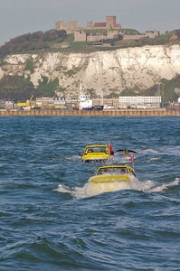 Reaching the first shipping lanes, wave chop had finally reduced to about 60cm (2 ft), with regular swells of twice this but it felt like a cruise compared to what had gone before. Our most immediate worry now was to get safely across the first shipping lane. The English Channel is the busiest shipping lane in the world and has a mandatory two-way system, ships travelling East to West on the English side and the reverse on the French.
Reaching the first shipping lanes, wave chop had finally reduced to about 60cm (2 ft), with regular swells of twice this but it felt like a cruise compared to what had gone before. Our most immediate worry now was to get safely across the first shipping lane. The English Channel is the busiest shipping lane in the world and has a mandatory two-way system, ships travelling East to West on the English side and the reverse on the French.
Those tankers, so slow when you look at them from the land, are actually travelling very fast indeed, amazingly giving us no more than 15 minutes from the time we first saw them until arrival. Two of them were unfortunately racing towards us, neck and neck and one missed by no more than a hundred metres (yards) and providing a huge wash (at least for Adam and I).
The wind began backing to the south contrary to all the weather forecasts meaning we were fortunately heading into the shelter of land as with mounting excitement, through the murk we could gradually discern low down on the water, a thin line - the French coast!
The cars ploughed gamely on, corkscrewing through the choppy conditions, all temperatures in the green, fuel use lower than expected and automatic bilge pumps cycling every now and then as yet another bigger wave gave us the good news.
Tim decided to gain another distinction and became the first amphibious car in history to get a rope caught around his front wheel in mid channel – you can’t take him anywhere! The emergency-use-only tow rope fitted on the front, had been torn loose by the waves and was now creating a little emergency of its own. It was not a good idea to let that to go through the propeller and so we had to stop. Although successful in poling it free we lost another fifteen minutes of daylight and the experience dashed our hopes of Adam being able to hop across to refuel Tim’s car whilst on the move. The experience proving beyond doubt that it was just too dangerous to bring the cars close together.
If they had been, the horizontal fender lines which stick out from the side of each car would have been smashed to pieces as the cars reverse rolled, crashing down on each other from a combined height of well over 150 cm (five feet).
Releasing the rope and another problem. A huge car ferry was now bearing down on us at full speed, seemingly miles off his normal route and way out of the shipping lanes. Our pilot radioed an emergency collision warning that we were in its direct path; to be immediately reassured that they were only coming to have a look at us doing the crossing, not to run us down.
If dry land had been available, we would have been out like a flash. To be slowly circled by a gigantic predatory wall of steel at close quarters is a very humbling experience.
Soon we were approaching the French shipping lane and stopped to refuel Tim’s car. He had a 10 gallon (50 litre) tank, whereas ours was twice that size. A brand new bought-for-the-purpose siphon pipe was thrown across to him but it would not fit as he had an anti-siphon device fitted – always problems. Fortunately a thinner pipe was located. This worked but lost us another twenty minutes to siphon just 20 litres (four gallons).
On the move again in declining chop. The cars had handled everything really well but the short chop still meant that a moments inattention to steering made the cars drift off course as one corner of the car after another was lifted up or pitched down. Several times we cut across each other or the pilot boat whilst looking somewhere else.
Cutting in front of the pilot boat did however enable Adam to get a good photograph of our astonished photographer Ben, hunched up on the foredeck in the freezing cold as the setting sun went behind clouds. At least we were partly warm with the heater blowing on our feet. This later caused us some funny looks with dry bottoms to our jeans but wet tops.
The fast ebbing tide was now sweeping us away to the West. Unfortunately, as small boats have to cross the shipping lanes at ninety degrees by law, our wish to steer in a diagonal line for Calais was constantly frustrated, complicated further by having to turn to the West several times to pass port to port with oncoming high speed tankers on the French side. It would have been a shame to run one down.
By now the land was creeping slowly closer but Calais had been steadily slipping from our eleven o’clock to our half past nine, despite our radio calls to ask the pilot if he was actually setting the course or just following us!
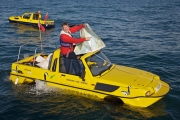 The sea was calmer now with much reduced chop and occasional large swells. It gave us time to reflect on an exciting crossing with a wide verity of sea states but it really did feel like it was now time to get there. We were also very concerned over the fading light and at how far West we seemed to have been taken from Calais, where friends and press were waiting.
The sea was calmer now with much reduced chop and occasional large swells. It gave us time to reflect on an exciting crossing with a wide verity of sea states but it really did feel like it was now time to get there. We were also very concerned over the fading light and at how far West we seemed to have been taken from Calais, where friends and press were waiting.
Adam raised the French courtesy flag. Percy was making friends as gannets flew low overhead and Adam demonstrated his ability to miss them all with the camera. No one had felt even the remotest sea sick and Tim still smiled and held his thumb up every now and then.
Crossing a few hundred meters (yards) East of the deep channel approach buoy, and just East of Sangatte, we approached land at last. Due to the fading light, the pilot asked if we wanted to drive up the beach and along the road to Calais. Unfortunately, when asked, he did not know the beach or even if there was a way off it! The sand dunes rising to the rear convinced us that even if we had not been still determined to get to Calais by sea, we were certainly not going to take the risk of getting stuck in soft sand on a beach with no way off.
Hugging the shoreline, just a few hundred meters off in order to get out of the savage tidal flow we at last and for the first time on the crossing, turned directly for Calais with a tide reduced ground speed of only 3Km (1.8 mph) and Km (miles) still to run.
Light was now fading badly. It was time to switch on the navigation and headlights and have some chocolate raisins. As we ground eternally onwards for Calais, we considered that we could have landed on the beach in about five hours and twenty minutes despite the stops.
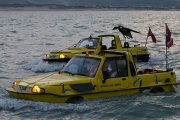 The press and Television crews had been in touch several times as they had hoped to cross by ferry to film us landing but we were just too far behind schedule and they had to give it a miss. We were announced as having arrived after six hours anyway - we wished!
The press and Television crews had been in touch several times as they had hoped to cross by ferry to film us landing but we were just too far behind schedule and they had to give it a miss. We were announced as having arrived after six hours anyway - we wished!
We were left remorselessly grinding on in the dark towards a place we had never been to and with no one to welcome us. Hoping we had done enough to publicise the nature reserve problems but feeling that perhaps we had failed without publicity of the final landing.
Car ferries passed to our port side, looking like illuminated fairy castles and we could see a gathering number of people walking along the shore in the growing dark and cold. It took some time before we realised that the highly unusual sight of two amphibious cars with navigation and headlights on was providing them with a nice if somewhat cold evening stroll and entertainment as they easily kept abreast.
In almost pitch darkness we finally crept around the end of the massive timber breakwater and into Calais harbour. Just visible were two people at the end of the breakwater, jumping up and down cheering - Rene and Katty still waiting for us despite the well overdue schedule and bitter cold. What can you say for friends like that?
An absolutely fantastic sight unfolded as the brightly coloured shoreline reflections shone out across the water. Tired as we were, we could not help but grin at the pure novelty and wonder of it all.
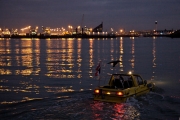 We had been advised to come out on the old hovercraft ramp just inside the breakwater and the pilot directed us to it. Lining both cars up for a multiple landing we went full speed for the ramp. It was just visible in the darkness with an even blacker line across it at water level – seaweed? Even over the noise of the engines we heard shouting and could just make out Rene and Katty running hard along the top of the breakwater, throwing their arms about. We halted 20 metres (yards) from the shore. No one shouts like an experienced adventurer and here we had two. They must have been heard all over Calais!
We had been advised to come out on the old hovercraft ramp just inside the breakwater and the pilot directed us to it. Lining both cars up for a multiple landing we went full speed for the ramp. It was just visible in the darkness with an even blacker line across it at water level – seaweed? Even over the noise of the engines we heard shouting and could just make out Rene and Katty running hard along the top of the breakwater, throwing their arms about. We halted 20 metres (yards) from the shore. No one shouts like an experienced adventurer and here we had two. They must have been heard all over Calais!
It seemed we had been heading not for an area covered by seaweed but actually the severed raw end of the old concrete slipway complete with underwater obstructions. It would have torn the bottoms out of us if they had not been there to warn us off. Not only that but there was no way out at the top either. So much for forward planning and taking information from others!
Before setting off running again for the land end of the breakwater, Rene and Katty shouted to us to go back out of the harbour and they would see us on the beach. Back out of the harbour (was this trip never going to end?) and again rounding the breakwater, the beach just appeared black to us with a shining bit at the bottom. We headed cautiously in, the cars simply greasing themselves onto the beach as if it had been absolutely nothing. We had arrived. 7 hours and nine minutes.
Two figures then appeared this time running down the beach, gasping “keep tight to the left and don’t stop whatever you do”. Twice the cars almost bogged down in the very soft sand but pulled clear again before running on like thoroughbreds - and so at last onto a firm concrete surface.
Peace descended as the engines were switched off in the biting cold of a freezing night. Through the darkness we could just make out two figures, still running but this time back up the beach before arriving breathless. A heartfelt thank you Rene and Katty. Long may you keep fit!
A really nice French crowd arrived. Katty took a photo and then gave us the bad news. They are all mad in France and drive on the wrong side of the road, plus It was miles to the ferry terminal because the bridge was up! Tired, after dark and with no map was not the best time to consider this. Tim had driven on the continent many times before and was supposed to be our magic bullet for an occasion like this but he was in worse condition than us, having been kept in solitary confinement during the crossing and spent longer on the road than us to get to Dover.
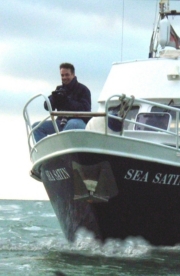 No problem, Rene and Katty would lead the way. With Percy enjoying the sites as he flew happily around the thousands of roundabouts that Calais seems to consist of we at last reached the ferry terminal.
No problem, Rene and Katty would lead the way. With Percy enjoying the sites as he flew happily around the thousands of roundabouts that Calais seems to consist of we at last reached the ferry terminal.
Our only problem was that we seemed to have lost Ben, our photographer, who was due to join up with us. We finally just had to leave and to our great relief managed to contact him in mid channel, he was about there too, going back with the boatman.
Last minute worries as we entered the ferry terminal – an unexpected customs check of every vehicle was taking place and here we were, two soaking wet nuts in an unusual vehicle, loads of mess and spare fuel in the back while flying a plastic goose from the mast - it was going to be an even longer night! But no, a quick flash of the torch, a grin and “your mate is just ahead of you” and we were through.
Greeted at Dover with a flat trailer tyre and no jack, the day and night ground on as in sub zero temperatures and still wet, we raided some road works for bricks to lift the trailer up onto. Foot down time for home was greeted by freezing fog the whole way, and significant diversions – at least we knew it was dear old England!
We have been asked if the crossing is going into the Guinness book of records? The answer is no. Our view and that shared by many other people out there who ‘have a go’ or donate their time to wildlife, is that only one thing matters or makes a record is to have done it! We are all record breakers in our own way.
This was:
- The world’s first successful crossing of the English Channel by two amphibious cars.
- The world’s first successful crossing of the English Channel by two amphibious cars of the same kind.
- The world’s first amphibious car to get a rope caught around its front wheel in mid Channel!
- And most importantly, – Percy is the world’s only ever plastic goose to fly the English Channel following an amphibious car!
All photo’s by Ben Plewes, for more fantastic photos click here
To see the latest news about the wildlife project that the crossing was made for click here